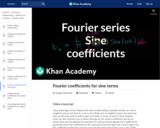
Fourier coefficients for sine terms. Created by Sal Khan.
- Subject:
- Applied Science
- Engineering
- Material Type:
- Lesson
- Provider:
- Khan Academy
- Provider Set:
- Khan Academy
- Author:
- Sal Khan
- Date Added:
- 08/04/2016

Fourier coefficients for sine terms. Created by Sal Khan.
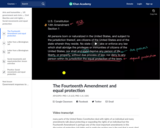
An overview of The Fourteenth Amendment and equal protection.
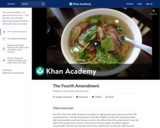
A deep dive into the Fourth Amendment, which protects citizens from unreasonable searches and seizures. In this video, Kim discusses the Fourth Amendment with scholars Orin Kerr and Tracey Meares.

Understanding the weak points of Fractional Reserve Banking. Created by Sal Khan.

Sal draws a free body diagram for a box held stationary against a wall with a force at an angle theta.
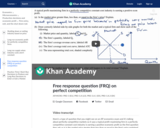
Walk through the solution to a free response question (FRQ) like the ones you may see on an AP Microeconomics exam. Topics include why price equals marginal revenue (P=MR) for a perfectly competitive firm, how to draw side-by-side market and firm graphs, and how to find several points of interest in the firm graph.

This tenth grade annotated inquiry leads students through an investigation of the French Revolution. Adolescent students are quite concerned with challenging authority and establishing their independence within the world; the concept of revolution brings those two concerns to their most world-altering levels. This inquiry gives students an entry point into thinking like historians about the French Revolution. The question of success invites students into the intellectual space that historians occupy. By investigating the question of the French Revolution’s success, students will need to make decisions about what the problems of the Revolution were, how to give weight to the events of three different periods of the Revolution, and what distance, if any, was between intentions and effects.
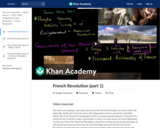
Part 1 of the French Revolution. From the Convocation of the Estates General to the storming of the Bastille.
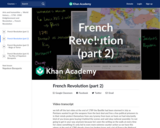
Royals try to escape. Champ De Mars Massacre. Declaration of Pillnitz. Movement towards becoming a Republic. Created by Sal Khan.

The Reign of Terror. Created by Sal Khan.
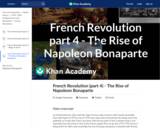
The rise of Napoleon Bonaparte. Created by Sal Khan.

In the 1600s, French and Dutch settlers in North America took a very different approach to colonization than their English or Spanish counterparts. In this video, Kim examines the trading relationships that French and Dutch settlers established with Native Americans in North America and how colonial goals affected patterns of settlement.

Napoleon's disastrous invasion of Russia. Created by Sal Khan.
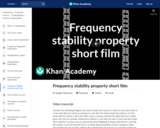
Can you tell the difference between actions based upon flipping a coin and those based upon blind guessing or simulating randomness? This short video examines the frequency stability property. Created by Brit Cruise.

In 1845 Frederick Douglass published what was to be the first of his three autobiographies: the Narrative of the Life of Frederick Douglass, an American Slave, Written by Himself. As the title suggests, Douglass wished not only to highlight the irony that a land founded on freedom would permit slavery to exist within its midst, but also to establish that he, an American slave with no formal education, was the sole author of the work.

What was it like for hunter-gathers? What were their favorite foods that they would go the extra mile to get their hands on? How are decisions like that different from the decisions we make today? Created by Big History Project.

In the years after World War I Americans quickly reached the conclusion that their country's participation in that war had been a disastrous mistake, one which should never be repeated again. During the 1920s and 1930s"”recognized as the Interwar Period (1921-1939)"”U.S. officials pursued a number of strategies aimed at preventing war.

In this video excerpt from NOVA, find out how the discovery of a gene defect has led to the development of a new drug to treat patients with cystic fibrosis.
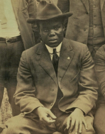
A lesson plan on Hubert Harrison is available, with sections adapted for use with students in grades 2–5, 6–12, and beyond.An engaging and accessible introduction to Hubert Harrison is the goal of this lesson plan for children in grades 2–5, which incorporates interactive storytelling, creative exercises, and fundamental terminology. Younger students have a deeper understanding of Harrison's life and work during the Harlem Renaissance and his Caribbean / Danish West Indian heritage.The 6th–12th grade lesson plan delves deeply into Harrison's activist and scholarly endeavors. Analytical and critical thinking skills are developed through activities such as evaluating sources, giving speeches on civic responsibility, and conducting research. This section is designed to encourage older students to dig further into the complicated lives of historical figures and the contexts in which they lived, and to draw parallels between past and present issues.In addition to studying Harrison, this lesson plan provides students with a deeper understanding of how their actions can lead to societal shifts.

Meet John Resig, the developer that invented jQuery and now works as an engineer at Khan Academy.